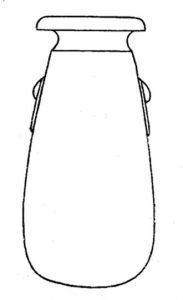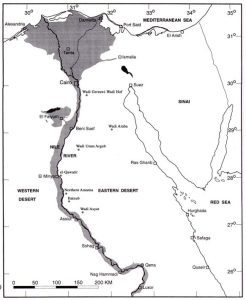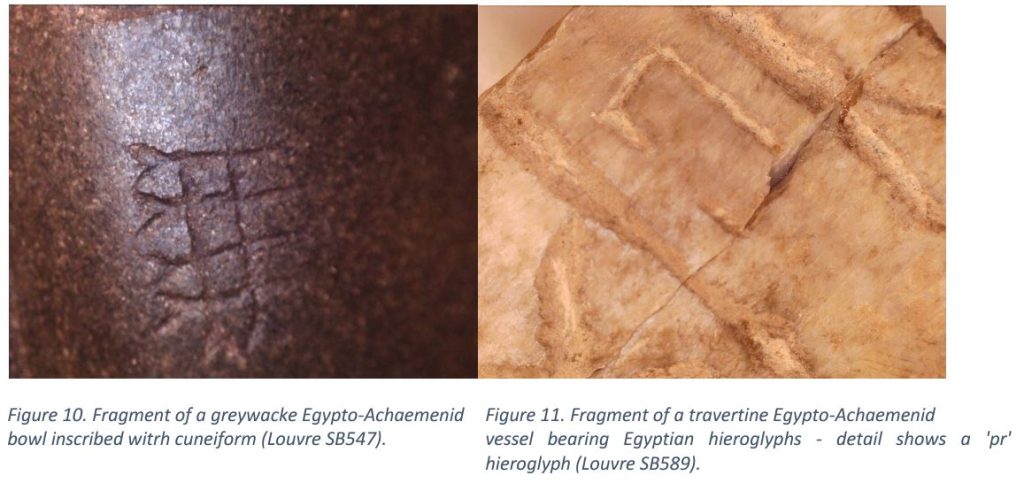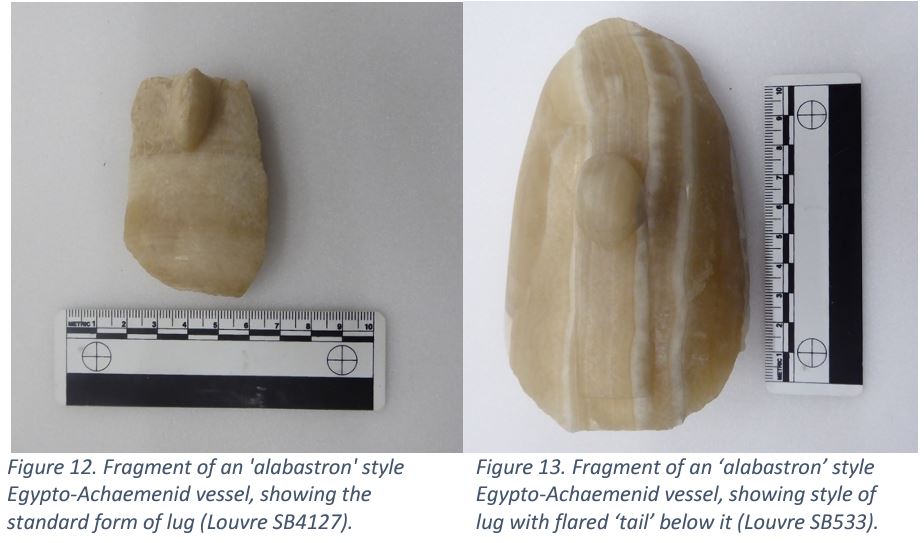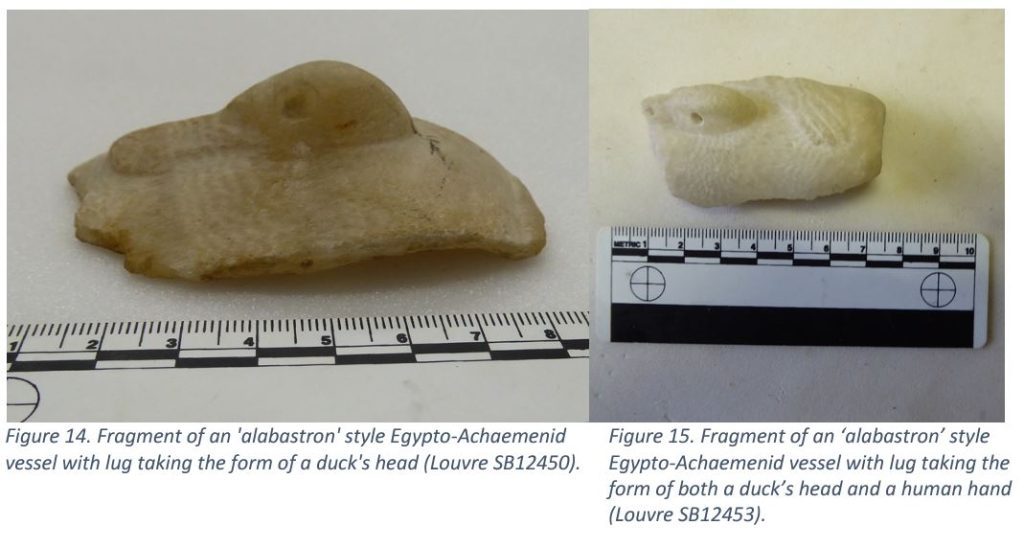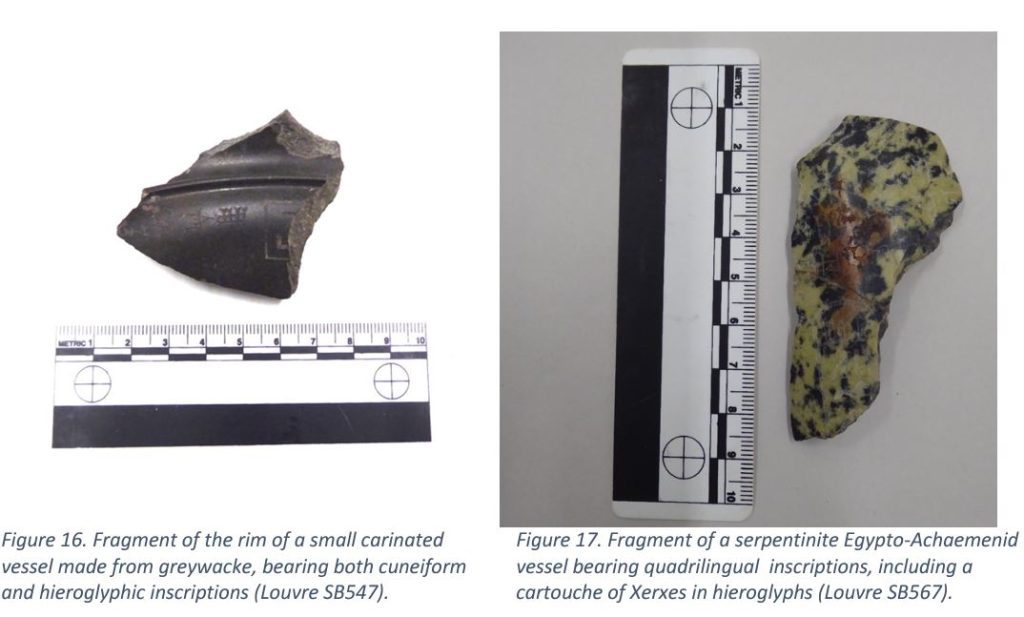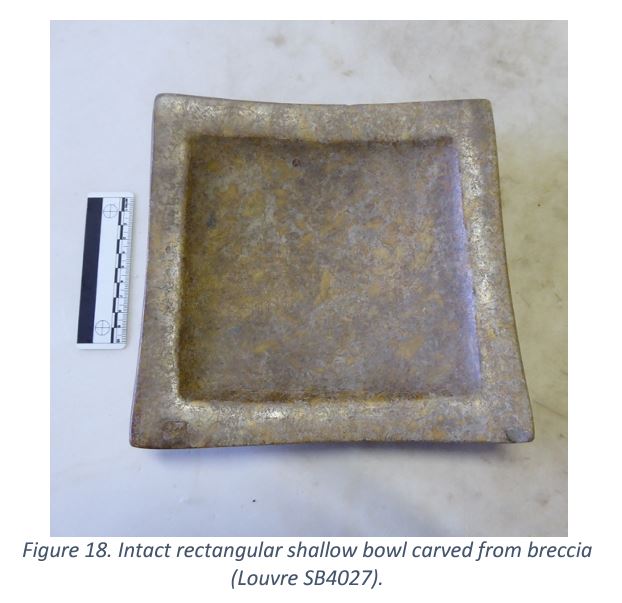October 2018 | BIPS Research Grant
Introduction: principal aims of the project
This research project is a study of Egypto-Achaemenid stone vessels (dating from the mid- to late 1st millennium BC) held in the collection of the Louvre. We also studied vessels dating to the Late Bronze Age within the Louvre collection (see Fig. 1), in order to place the EgyptoAchaemenid examples in a wider chronological context. Our eventual publication of the work will also integrate observations concerning vessels in other collections, including the British Museum, the Peabody Museum (Yale University), the National Museum of Iran (Tehran), and the Bible Lands Museum (Jerusalem). Our broad aim is to use these artefacts to gain a greater understanding of aspects of Egypt’s cultural and technological position within the Achaemenid empire of the 5th and 6th centuries BC, via detailed material and morphological analyses.
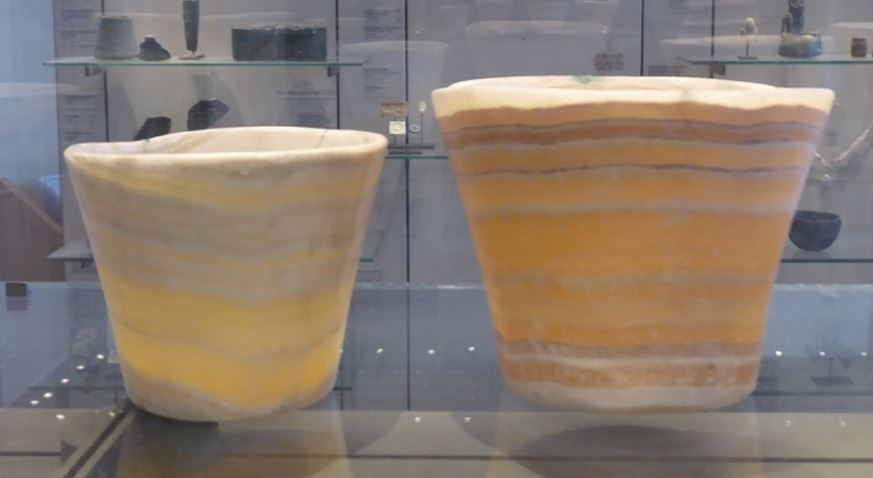
Figure 1 Two vessels from a Late Bronze Age cache at Susa (Louvre SB2723-45-46). The shapes are non-Egyptian, and they were probably manufactured from local (i.e. non-Egyptian) travertine.
These types of Egypto-Achaemenid vessels, many of which were inscribed with multilingual texts, have largely been found outside Egypt, particularly in Susa and Persepolis. The standard form of the vessels is identified as ‘alabastron’ in Barbara Aston’s monograph on Egyptian stone vessels (Aston 1994), comprising a closed form, narrower at the top than the base, with a rounded bottom and a thick everted rim (see Fig. 2). There are, however, also some examples of open forms such as bowls. The purpose of these vessels, which rarely exceed 40 cm in height, seems to have been primarily to contain such liquid or semi-liquid luxury products as oils, unguents and perfumes. They are largely made from Egyptian travertine, and vessels of broadly this type and material have played an important role in Egypt’s élite contacts with the outside world since at least the 3rd millennium BC. Through our study of the materials, vessel shapes and production methods, we are seeking to gain a clearer understanding of the chaîne opératoire through which the Egypto-Achaemenid vessels were quarried, roughed out, shaped and inscribed – which stages of this process may have taken place within Egypt and which were undertaken at their ultimate destinations?
The nature and principal sources of Egyptian travertine
Egyptian travertine (a form of calcium carbonate, also frequently known as ‘Egyptian alabaster’) is an extremely versatile and attractive stone, highly valued by the Egyptians from the late 4th millennium BC onwards. Three variants of travertine are found in Egypt: (1) an opaque, milky white calc-sinter that is fine-grained (crystals < 1 mm) with little or no layering, which seems to have only rarely been used by the ancient Egyptians; (2) a frequently-used translucent coarse-grained, fibrous calcsinter (coloured in shades of pale brown or yellowish- to orangey-brown with faint to marked layering); and (3) a strikingly banded calc-sinter comprising an interlayering of the other two forms, which was also frequently used. The brownish colouring of types 2 and 3 – derived from minute traces of iron oxide deposited by groundwater – fades to white after exposure to the sun.
Small deposits of travertine occur sporadically in the Eocene limestones of the Nile Valley and adjacent desert (mainly to the east of the Nile) between Cairo and Esna (see Fig. 3). The principal known occurrences of Egyptian travertine comprise – from north to south – the Wadis Gerrawi and Hof (near Helwan), Wadi Araba, Wadi Umm Argub, el-Qawatir, northern Amarna (Gebel Sheikh Said and Wadi Bershawi), Hatnub, Wadi Asyut and Gebel Rokham, and in the cliffs on the west bank at Luxor. Of these, however, Hatnub (see Shaw 2010) is the major known Egyptian source, and its importance is indicated by the fact that the stone itself is frequently described in Egyptian texts as ‘pure white stone of Hatnub’. Egyptian travertine had many uses, ranging from the lining and paving of buildings (e.g. the valley temple of Khafra at Giza, and the mortuary temple of Unas at Saqqara) to the creation of colossal statues, and the making of receptacles, particularly unguent vessels.
Thus, in our study of the Egypto-Achaemenid travertine vessels at the Louvre, we have sought to use both our first-hand familiarity with the travertine quarries at Hatnub, and our knowledge of Egyptian travertine vessels of many different periods in order to contextualise and better understand their chaîne opératoire.
Selection and sampling of the Egypto-Achaemenid vessels held in the Louvre
Our initial intention was to examine the 56 complete travertine vessels and fragments listed by Georges Posener (1936) as examples of multilingual Egypto-Achaemenid vessels. In the event, we were confronted with a much larger quantity because the Louvre had also provided us with numerous examples of both whole vessels and fragments that were not listed by Posener (who had deliberately excluded from his publication those vessels and fragments bearing no traces of hieroglyphic inscription). We therefore devised a sampling strategy in order to maximise both the time available and the data presented to us by the artefacts. We focused on taking photographs and microphotographs of items that fitted the following criteria:
- good examples of high quality vessels made from materials that seemed highly likely to be of Egyptian origin (primarily travertine, greywacke and breccia);
- good examples of vessels (varying in date from Late Bronze Age through to the late 1st millennium BC) that appeared to be made from non-Egyptian materials (primarily local forms of travertine or limestone);
- vessels or fragments on which the methods used to apply inscriptions were either or very high or poor quality;
- ‘alabastron’-shaped vessels or fragments that have been furnished with either standard or highly distinctive lug types.
These four criteria were chosen primarily in order to help us to reconstruct aspects of the chaîne opératoires of Egypto-Achaemenid stone vessels on the basis of our sample of the vessels and fragments held at the Louvre (see attached excel sheet for this data).
Study of materials used for the vessels
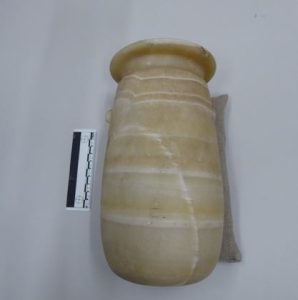
Figure 4 ‘Alabastron’ style 27th-Dynasty vessel made from Egyptian travertine, excavated from Susa (Louvre AO2634)
In our chosen sample of objects, we were trying to choose a spectrum of different forms of travertine, some of which seem characteristically Egyptian (i.e. cream, yellow and light brown banded stone, with a dense smooth appearance, with some inclusions, in section, see Fig. 4) and others seeming to be a more crystalline type of rock in section, with a tendency towards grey sheen and more obvious herringbone pattern on surface (see Figs 5 and 6). There are also post-Achaemenid ‘bottle’ styles of vessel which show both poor quality (probably local, i.e. non-Egyptian) travertine and vessel-making craftsmanship which appears to be below the usual level of Egyptian products (see Fig. 7, comparing Egyptian and non-Egyptian forms of travertine). The possible nonEgyptian craftsmanship of one post-Achaemenid local example also appears to be demonstrated through the presence of some kind of lathe-style hole at the base of the vessel (see Fig. 8; and see also Sparks 2001 for Late Bronze Age Levantine workshops in which craftsmen produced stone vesssels using local materials and techniques).
In other objects we sought to identify a changing spectrum of quality of carving of inscriptions, mostly finding the carving of the hieroglyphs in particular to be scratches and pecking rather than full incised carving, suggesting perhaps that the finished vessels were exported to Susa etc and then inscribed on arrival, by relatively unskilled craftsmen. A possible working hypothesis is that there might be some link between the quality of carving employed for inscriptions and the question of whether the travertine is Egyptian or non-Egyptian (see, for instance, Fig. 9, for high quality Egyptian travertine but relatively poor carving). It is also worth noting that inscription carving on greywacke and serpentinite, despite both being much harder stones than travertine, is often of a very high quality than the inscriptions on travertine, whether local or Egyptian.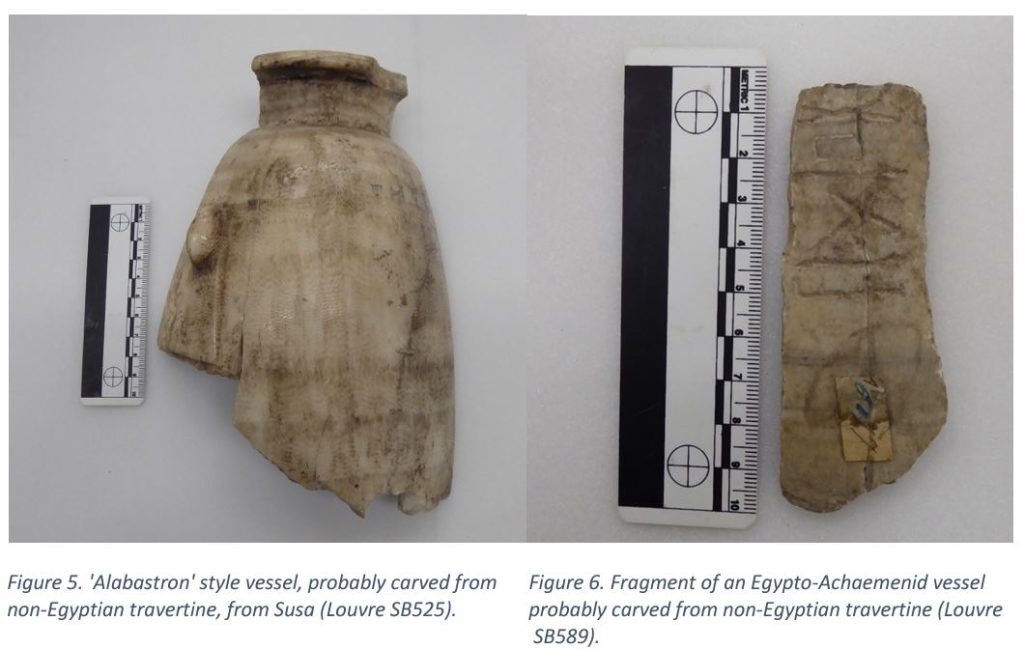
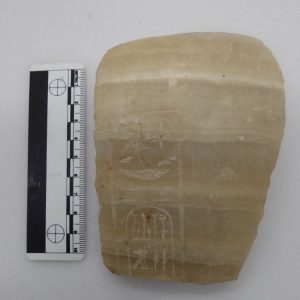
Figure 9 Fragment of an ‘alabastron’ style Egypto-Achaemenid vessel from Susa, bearing part of the name and titles of Xerxes (Louvre D60)
With these issues in mind, we took micro-photographs of the carved inscriptions of the following intact vessels and fragments of vessels:
- AO2634 (intact travertine vessel: cuneiform & hieroglyphs),
- D60 (intact travertine vessel fragment: hieroglyphic bit sign above cartouche; hieroglyphs) • SB525 (travertine vessel fragment: cuneiform),
- SB547 (greywacke vessel fragment) (cuneiform, hieroglyphs) [see Fig. 10],
- SB561 (intact travertine vessel: cuneiform & hieroglyphs),
- SB567 (serpentinite vessel fragment: hieroglyphs, including Xerxes cartouche, and cuneiform),
- SB571 (travertine vessel fragment: cartouche and border lines; and aleph-bird sign in cartouche),
- SB589 (travertine vessel fragment: hieroglyphs, including a pr sign) [see Fig. 11],
- SB599 (travertine vessel fragment: two parts of the cuneiform inscription),
- SB4128 (travertine vessel fragment: cuneiform),
- SB4131 (travertine vessel fragment: hieroglyphic bird sign and pr sign),
Lugs on ‘alabastron’ vessels
We also identified a range of different types of lug on the vessels, the smaller more bottle-like vessels tending to have small, simple lugs (Fig. 12), but the larger, more squat types tending to have lugs with ‘tails’, occasionally quite flared (Fig. 13). There were, however, also a few more unusual examples, such as a lug carved into the form of a duck’s head (SB12450, see Fig. 14), and another combining a duck’s head with a human hand (SB12453, see Fig. 15). We examined and photographed the following items:
- SB12450 Fragment of a travertine vessel, lug in the form of duck’s head
- SB12453 Fragment of a travertine vessel, lug in the form of duck’s head and hand
- SB18429 Fragment of a travertine or limestone vessel rim, carved into the form of a finger and part of a hand(?)
- SB12454 Fragment (near the neck) of a travertine jar – the lug is carved into some unrecognisable form
Egyptian stone types (other than travertine) apparently used for Achaemenid artefacts
In addition to the travertine vessels, we were able to examine a large number of hard stone artefacts, some of which appeared to be likely to have been quarried in the Egyptian Eastern Desert. Many of these are mentioned (often with partially or wholly incorrect geological identifications) by Pierre Amiet (1990) in his study of fragments of artefacts from the Persian treasury at Susa, and our project provided an excellent opportunity to reassess these items.
We examined and photographed the following artefacts, grouped according to stone types:
GREYWACKE
- SB547 rim fragment of a vessel inscribed with hieroglyphs (including cartouche of Xerxes) and Akkadian cuneiform (Amiet 1990: object 3) [see Fig. 16]
- SB548 large fragment of carinated shallow bowl inscribed with Elamite and Old Persian texts, including cartouche of Xerxes (Amiet 1990: object 4)
- SB3766 fragment of a disc of probable greywacke, carved with image of gazelle (probably a form of architectural inlay)
- SB3772 fragment of a rectangular tablet carved with images of bird and flowers (probably a form of architectural inlay)
- SB11880 chunky fragment from a large vessel SB23330 leg fragment from base of a tripod bowl
- SB9426 leg fragment from base of a tripod bowl (Amiet 1990: object 18) SB9427 leg fragment from base of a tripod bowl (Amiet 1990: object 13)
- SB9428 leg fragment from base of a tripod bowl SB11523 leg fragment from base of a tripod bowl (Amiet 1990: object 15)
- SB11525 leg fragment from base of a tripod bowl (Amiet 1990: object 17)
- SB18427 leg fragment from base of a tripod bowl (Amiet 1990: object 16)
- SB18442 frag of large carinated bowl (Amiet 1990: object 12)
SERPENTINITE
- SB567 fragment of ‘alabastron’ vessel bearing quadrilingual texts (Egyptian, Elamite, Old Persian & Akkadian) including cartouche of Xerxes (Amiet 1990: object 2) [see Fig. 17]
- SB18435 fragment of small circular bowl fragment (Amiet 1990: object 5)
- SB18437 fragment of inscribed hard stone vessel (Amiet 1990: object 9)
- SB18443 fragment of small bowl fragment (Amiet 1990: object 23)
BRECCIA
- SB1792? corner frag of square shallow bowl
- SB18441 rim fragment of small bowl (Amiet 1990: object 8)
- SB4027 large complete square shallow bowl (Amiet 1990: object 24) [Fig. 18]
AS YET UNIDENTIFIED BLACK, SILVER-FLECKED HARD STONE
- SB1801 fragment of small carinated vessel
- SB1802 fragment of small carinated vessel
- SB18436 fragment of small carinated vessel (Amiet 1990: object 10)
- SB18438 fragment of small carinated vessel
- SB18439a&b fragment of small carinated vessel (Amiet 1990: object 22)
From the above lists of artefacts, mainly vessel fragments, it is clear that, in addition to the better known Egypto-Achaemenid travertine ‘alabastron’ style vessels, the Achaemenid elite were also having artefacts produced with a number of hard stones deriving from the Egyptian Eastern Desert – some of the hard stone vessels may have been Egyptian in style, but it is clear that many are Achaemenid forms.
The greywacke vessel fragments are of considerable importance to the study of the chaîne opératoire because this stone has only one source, located in the Wadi Hammamat region of the Egyptian Eastern Desert. Apart from the archaeological evidence of quarrying during the Persian period, numerous rock-cut cartouches of Xerxes indicate exploitation of the resource during his reign. Large statues of greywacke were also procured from this source and transported to Persia, where examples have been excavated at Susa (Bloxam et al. 2014; Bloxam 2015). This realisation that both large and small greywacke objects were directly procured in Egypt will enhance our research aims in exploring the role that stone procurement and crafting played in the dynamics of Egyptian-Persian relations at the time of Xerxes.
Discussion
The above report indicates the areas of research on which we focused with regard to the collection of Egypto-Achaemenid stone vessels in the Louvre. Our publication will focus primarily on issues relating to the materials and production methods employed for these vessels, and our ultimate aim is to seek to understand which aspects of the chaine operatoire took place in Egypt, and which were being undertaken by Egyptian and non-Egyptian craftsmen at the Achemenid court in Susa and elsewhere within Persia.
References
Amiet, P. 1990. ‘Quelques epaves de la vaisselle royal Perse de Susa’, Contribution à l’histoire de l’Iran: Mélanges Jean Perrot, ed. F. Vallat (Paris: ERC), pp. 213-224.
Aston, B.G. 1994. Ancient Egyptian Stone Vessels: Materials and Forms (Heidelberg: Heidelberger Orientverlag).
Aston, B.G., Harrell, J.A. and I. Shaw 2000. ‘Stone’, Ancient Egyptian Materials and Technology, ed. P.T. Nicholson and I. Shaw (Cambridge: Cambridge University Press), pp. 5–77.
Bloxam, E. 2015. ‘ “A Place Full of Whispers”: Socialising the Quarry Landscape of the Wadi Hammamat’, Cambridge Archaeological Journal 25/4: 789-814
Bloxam, E., Harrell, J., Kelany, A., Moloney, N., El-Senussi, A., and Tohamey, A. 2014 ‘Investigating the Predynastic origins of greywacke working in the Wadi Hammamat’, Archéo-Nil 24: 11-30
De Putter, T. and C. Karlshausen 1992. Les pierres utilisées dans la sculpture et l’architecture de l’Egypte pharaonique: guide pratique illustré (Brussels: Connaissance de l’Egypte Ancienne).
Klemm, R. and D. Klemm 2008. Stones and Quarries in Ancient Egypt (London: British Museum Press).
Posener, G. 1936. La Première Domination perse en Égypte (Cairo: IFAO). Shaw, I. 2010. Hatnub: Quarrying Travertine in Ancient Egypt (London: Egypt Exploration Society).
Sparks, R., 2001. ‘Stone vessel workshops in the Levant: luxury products of a cosmopolitan age’, The Social Context of Technological Change: Egypt and the Near East, 1650-1550 BC, ed. A.J. Shortland (Oxford: Oxbow Books), pp.93-112.
